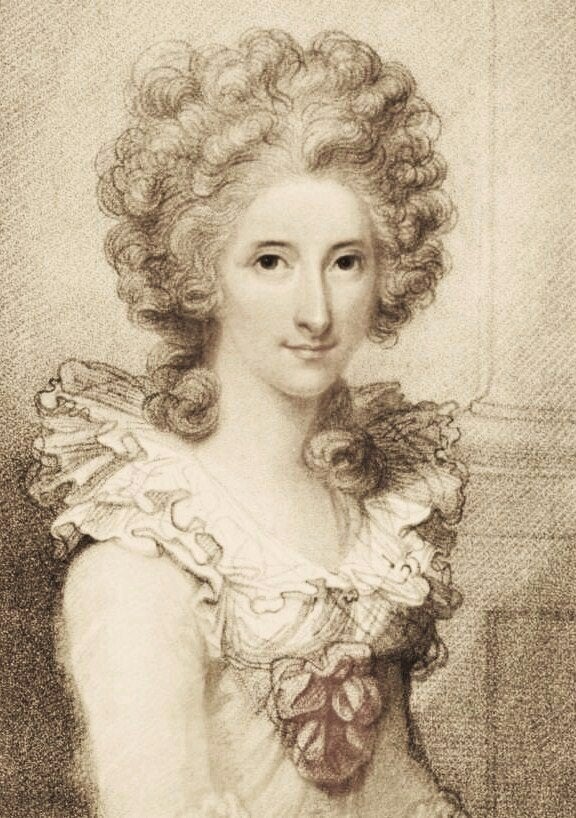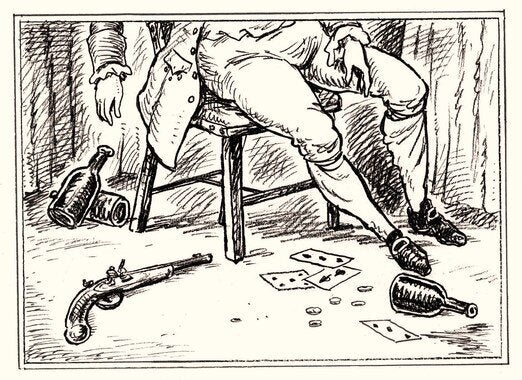

One dank Saturday afternoon last year, I snapped up the Georgian portrait you see here in a near-empty Northamptonshire junk shop. It was ticketed at £12, but the bored proprietor had switched off the central heating, and seemed more interested in retreating to the welcoming bosom of the alehouse, so I haggled him down to £8. Even so, you might think I was robbed, since - with all due respect to the sitter - it is a fairly unremarkable picture. But the lady shown was one of the more interesting characters of the late 1700s, and I was delighted to have chanced upon her. Her name is Anne Damer.
Anne crops up briefly in my scandalous magnum opus, The Gin Lane Gazette, as the story of her profligate husband's suicide is perfect tabloid fodder. John Damer's gambling debts amounted to a staggering £70,000, and in 1776 he blew his own brains out in a Covent Garden pub, after a raucous dinner with four prostitutes and a purblind fiddler. Anne's friend, the equally dissipated Whig, Charles James Fox, broke the grim news to her, but John Damer's sudden demise freed her to pursue a colourful life as an artist.
Anne was born Anne Seymour Conway in 1749, and her father's secretary, David Hume, seems to have encouraged her to develop her interest in sculpture. She was also taken under the wing of the gossipy old aesthete Horace Walpole, who became her guardian during her parents' foreign excursions, and a devoted fan of her work.
Anne married John Damer in 1767, but left him after seven years, exasperated by his ruinous extravagance. It is reported that he insisted on wearing three separate - and expensive - sets of clothes every day, and the strain of his debts to Jewish moneylenders proved insupportable. After his suicide, Anne indulged her taste for European travel, and she was once kidnapped by a privateer during a sea passage. She studied Greek and Latin, and also took lessons in modelling and anatomy, becoming a sculptress of great renown. She sculpted Joseph Banks, the botanist who made his name sailing the Pacific with Captain Cook, and who later organised the ill-fated mission of HMS Bounty; Horatio Nelson, whom she had met in Naples, in the company of Sir William Hamilton; King George III, rendered in marble by Anne in the early 1790s; and the god Apollo, her ten-foot statue of whom was placed in the Drury Lane Theatre. A self-portrait in marble graces the Uffizi in Florence, and she had thirty-two pieces exhibited at the Royal Academy over a period of thirty-four years.

Anne cultivated intense female friendships throughout her life, with women such as the celebrated actresses Sarah Siddons, and Elizabeth Farren. Speculation about her 'Sapphick' proclivities was rife, and Hester Thrale observed that she was 'a Lady much suspected for liking her own Sex in a criminal Way'. Anne also took to wearing men's clothes, and was often seen sporting a man's hat, shoes, and jacket, while yomping over fields, and clutching a hooking stick. A cane became her trademark - and 'Stick' became her nickname - when she took to carrying one after falling off a scaffold.
In 1789, Horace Walpole introduced her to Mary Berry (the author and playwright, not the Bake-Off woman), and they became exceptionally close. Anne acted as intermediary in the engagement of Mary and General Charles O'Hara, which ended unhappily in 1795 when O'Hara returned to his post as Governor of Gibraltar. Anne and Mary visited Paris in 1802, and met Napoleon, who made them a gift of a snuffbox encrusted with diamonds. They were also granted an audience with Boney's dear old mum. In return, Anne gave him a portrait bust of Francophile Charles James Fox, and another of the scourge of the French fleet, Horatio Nelson.
When Walpole died, he bequeathed Anne his grandiose, gothic pile Strawberry Hill, and she lived there for fourteen years. She wrote a romantic novel entitled Belmour in 1801, hosted plays, and acted in amateur productions. She died at her house in Grosvenor Square, London, in 1828, and, in accordance with her wishes, was buried with her dog's ashes, and her sculptor's tools.
Oh, and the portrait in a tatty frame that I bagged for £8...? There are copies in the British Museum, and the National Portrait Gallery.
The Gin Lane Gazetteon sale now!